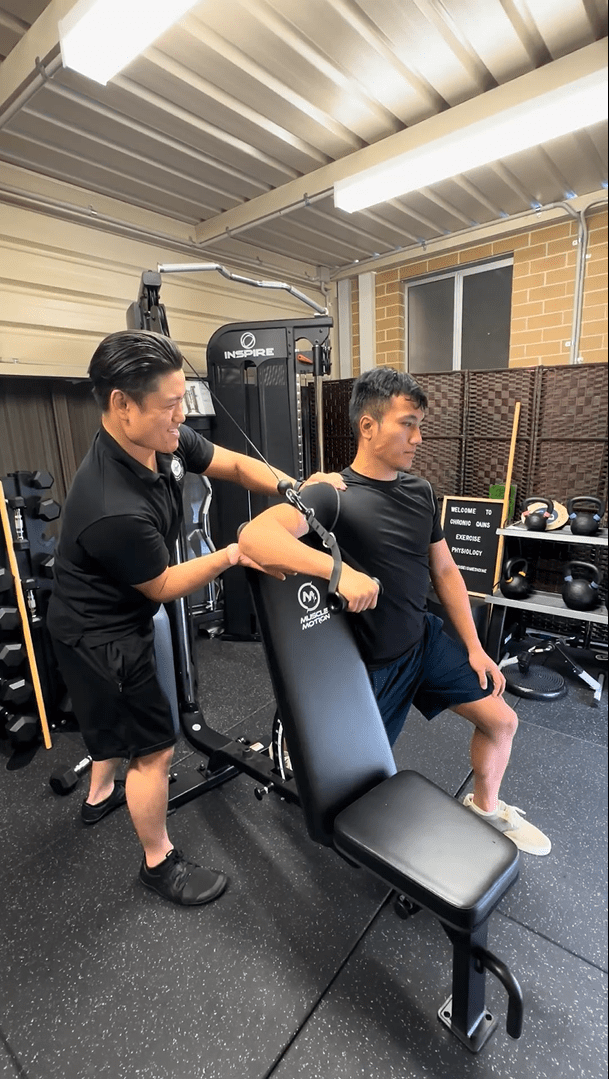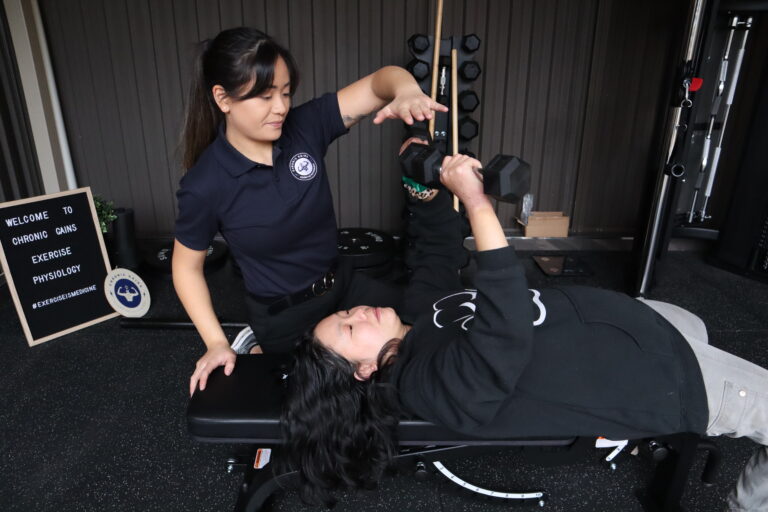Ensuring Safety and Best Practice in NDIS Exercise Physiology
Introduction
When you’re living with a disability, exercise isn’t just about “getting fit.” It’s about moving safely, building confidence, and reclaiming independence. For participants in Bankstown and across Sydney, exercise physiology within the NDIS isn’t about ticking boxes — it’s about ensuring every movement supports your health and life in the safest and most effective way possible.
At Chronic Gains, we believe in movement as medicine — but like any medicine, exercise must be prescribed with care. That means following evidence-based guidelines, tailoring programs to each person, and prioritising safety at every step. The goal is not just to avoid injury, but to empower you with the right tools, knowledge, and confidence to live more freely.
In this blog, we’ll explore what safety and best practice really look like in NDIS exercise physiology — from structured assessments to personalised planning, and from clinical guidelines to real-world support.
Why Safety Comes First

When it comes to exercise physiology under the NDIS, the first and most important principle is simple: safety is non-negotiable.
For many participants, exercise isn’t just about building strength or improving fitness — it’s about maintaining independence, reducing pain, and managing chronic conditions. But without the right safety measures in place, exercise can quickly turn from helpful to harmful. That’s why Accredited Exercise Physiologists (AEPs) spend so much time on screening, preparation, and tailoring programs before anyone even lifts a weight or steps onto a treadmill.
Safety begins with thorough assessments. Before designing a program, we take into account:
- Medical history (including past injuries, surgeries, or hospitalisations)
- Current medications (since many affect blood pressure, heart rate, or fatigue)
- Mobility challenges and functional limitations
- Any red flags that could make certain exercises risky
It also means thinking beyond the clinic. For example, a participant with epilepsy might need safety planning around potential seizures during physical activity. Someone living with osteoporosis needs strength training — but without the risk of high-impact movements that could cause fractures.
At Chronic Gains, our philosophy is that exercise should always build confidence, not fear. Safety is what allows participants to trust the process, try new movements, and believe in their body again. Without that foundation, even the best exercise program will fall short.
Individualisation — One Size Fits No One
If safety is the foundation, then individualisation is the blueprint. Every NDIS participant has unique abilities, health conditions, and life goals. That’s why generic exercise plans don’t work.
Think about it: telling someone to “just walk more” isn’t helpful if they use a wheelchair. Handing out a generic gym program won’t work if a participant’s main goal is to transfer independently from their bed to their chair. Real progress happens when exercise is designed around the person, not the protocol.
This is where Accredited Exercise Physiologists use a mix of clinical knowledge and creativity. We consider:
- The participant’s health status and any risks identified in screening
- Functional goals like cooking, shopping, or getting dressed
- Personal preferences (because enjoyment drives consistency)
- Environmental factors, like whether the person trains at home, in the community, or in a clinic
For example, someone living with Parkinson’s disease might focus on posture and balance training to reduce fall risk, while someone with autism might need sensory-friendly sessions in quiet spaces with clear, simple instructions. Both are “exercise programs” — but they look completely different because the people behind them are different.
Individualisation also means meeting people where they are. If fatigue, pain, or fear are barriers, we adapt the plan instead of forcing participants into something they can’t sustain. It’s about progress, not perfection.
At the end of the day, no two participants will ever receive the same plan from us — because no two lives are the same. And that’s exactly how it should be.
Best Practice in Action — Evidence, Not Guesswork

Safety and individualisation give us the foundation, but what truly guides an Accredited Exercise Physiologist is best practice — and that means leaning on evidence, not guesswork.
The world of exercise science is full of opinions, trends, and “quick fixes.” But when we’re working with NDIS participants, there’s no room for trial and error. Every exercise prescription must be backed by research, clinical guidelines, and professional standards from organisations like the American College of Sports Medicine (ACSM) and Exercise & Sports Science Australia (ESSA).
Best practice starts with the FITT principle — frequency, intensity, time, and type. But instead of rigid formulas, we apply these principles flexibly, adapting them to the individual. For instance:
- A participant with cardiovascular risk might be prescribed shorter, lower-intensity bouts of aerobic exercise, with close monitoring, rather than long continuous sessions.
- Someone with chronic pain might start with graded exposure — small, manageable exercises that build tolerance without flaring symptoms.
- A participant with intellectual disability might need simple, structured routines that are consistent and easy to follow, rather than complex progressions.
Best practice also means knowing what not to do. For example, avoiding deep forward flexion in someone with osteoporosis, or steering clear of overstretching in a participant with joint hypermobility.
But best practice is more than ticking boxes. It’s about connecting science to real life. The research may say that balance training reduces fall risk — but in practice, that means helping someone safely carry groceries home without losing confidence. The guidelines may recommend strength training twice a week — but in real life, that might look like practicing sit-to-stand so a participant can get up from the couch without help.
At Chronic Gains, we like to think of best practice as the bridge between research and reality. It’s not about applying guidelines in isolation — it’s about interpreting them in a way that makes exercise practical, safe, and empowering for each person we support.
Collaboration and Education
Safety and best practice don’t exist in a vacuum. They’re strengthened when everyone involved in a participant’s care is on the same page — and when the participant themselves feels informed, confident, and included in the process. That’s why at Chronic Gains, collaboration and education go hand in hand.
Why Collaboration Matters

NDIS participants often have a network of support — physiotherapists, occupational therapists, speech therapists, doctors, psychologists, support workers, family, and friends. If each professional works in isolation, it can lead to overlap, mixed messages, or even conflicting strategies.
By actively collaborating, we make sure exercise physiology:
- Aligns with therapy goals. For example, if a physiotherapist is working on gait retraining, we’ll build complementary strength and balance exercises rather than a competing focus.
- Reinforces daily function. If an OT highlights difficulty with shower transfers, we’ll prioritise lower-body strength, hip flexibility, and safe transfer practice.
- Supports mental wellbeing. If a psychologist is working with a participant on anxiety, we can design exercise sessions that avoid triggering environments and promote positive experiences.
- Includes the support team. Carers and support workers are often the ones helping participants with home exercise. We make sure they know how to assist safely, without feeling out of their depth.
This type of collaboration reduces confusion, saves energy for the participant, and creates a cohesive plan where every piece of support is pulling in the same direction.
Why Education Empowers

Even the best-designed program can fall short if a participant doesn’t understand why they’re doing it. Education transforms exercise from a set of instructions into a tool for independence.
We see education as a shared learning journey, not a lecture. It can include:
- Self-monitoring skills. Teaching participants to use the “talk test” or RPE scale to judge intensity, so they can exercise safely outside of supervised sessions.
- Pain vs. progress. Helping people distinguish between safe muscle effort and warning signs of injury, reducing fear and promoting confidence.
- Safe technique. From lifting a shopping bag without strain to practicing safe transfers, technique education reduces accidents and builds trust in one’s own ability.
- Condition-specific insights. For example, explaining to someone with multiple sclerosis why shorter bouts of activity are safer than long, fatiguing sessions.
Education isn’t about overwhelming participants with medical jargon. It’s about giving them the right tools, at the right time, in the right way — so they feel more in control of their own health journey.
Collaboration + Education = Confidence
When collaboration and education come together, participants don’t just follow a program — they own it. They understand what they’re working toward, why it matters, and who’s supporting them along the way.
For many NDIS participants, that shift from being a “patient” to being an active partner in their care is what truly unlocks independence.
At Chronic Gains, we see safety not as a barrier but as a pathway: a way to ensure every participant feels supported, informed, and confident enough to step forward on their own terms.
Safety as the Foundation of Progress
At its core, exercise physiology for NDIS participants isn’t just about movement — it’s about creating safe, purposeful, and empowering experiences that make life easier, healthier, and more independent.
Safety isn’t a checklist; it’s the foundation that allows real progress to happen. By starting with comprehensive assessments, tailoring programs to individual needs, following evidence-based guidelines, and fostering collaboration and education, we ensure that every step forward is both effective and sustainable.
At Chronic Gains, we believe that best practice is about more than rules and protocols — it’s about people. Every participant deserves to feel supported, understood, and equipped to take control of their health journey.
Because when safety and best practice come together, exercise becomes more than a session. It becomes medicine. It becomes empowerment. And most importantly, it becomes a bridge to living with greater strength, confidence, and independence. Contact us today to learn more about NDIS exercise safety.







